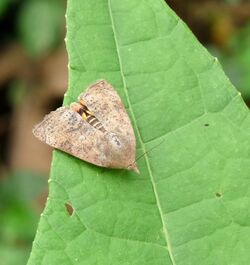Biology:Hyblaeidae
| Hyblaeidae | |
|---|---|

| |
| Hyblaea puera | |
| Scientific classification | |
| Domain: | Eukaryota |
| Kingdom: | Animalia |
| Phylum: | Arthropoda |
| Class: | Insecta |
| Order: | Lepidoptera |
| Clade: | Eulepidoptera |
| Clade: | Ditrysia |
| Clade: | Apoditrysia |
| Clade: | Obtectomera |
| Superfamily: | Hyblaeoidea |
| Family: | Hyblaeidae |
| Genera | |
| Diversity | |
| About 20 species | |
Hyblaeidae are the "teak moths", a family of insects in the Lepidopteran order. The two genera with about 18 species make up one of the two families of the Hyblaeoidea superfamily (the other family being the monotypic Prodidactidae),[1] which in the past has been included in the Pyraloidea. Recent phylogenetic studies find varying relationships of Hyblaeoidea among Ditrysian Lepidoptera: Mutanen et al. (2010) find the superfamily to group either with Pyraloidea, or – more often – with Thyridoidea or butterflies.[2] The results of Wahlberg et al. (2013) and Heikilä et al. (2015) indicate a sister-group relationship with Pyraloidea.[3][4]
Males have a specialised "hair-pencil" on the hindleg.[5]
The genus Hyblaea is distributed throughout the Old World tropics, and Torone in the Neotropics. Caterpillar host plants are well known and comprise almost exclusively species of the families Bignoniaceae, Verbenaceae, the mangrove families Avicenniaceae and Rhizophoraceae and a few other families.[6]
References
- ↑ Kaila, Lauri; Epstein, Marc E.; Heikkilä, Maria; Mutanen, Marko (2013). "The assignment of Prodidactidae to Hyblaeoidea, with remarks on Thyridoidea (Lepidoptera)". Zootaxa 3682 (3): 485–494. doi:10.11646/zootaxa.3682.3.9. PMID 25243303. https://www.mapress.com/j/zt/article/view/zootaxa.3682.3.9/33101.
- ↑ Mutanen, Marko; Wahlberg, Niklas; Kaila, Lauri (2010). "Comprehensive gene and taxon coverage elucidates radiation patterns in moths and butterflies". Proceedings of the Royal Society B: Biological Sciences 277 (1695): 2839–2848. doi:10.1098/rspb.2010.0392. PMID 20444718.
- ↑ Wahlberg, Niklas; Wheat, Christopher W.; Peña, Carlos (2013). "Timing and Patterns in the Taxonomic Diversification of Lepidoptera (Butterflies and Moths)". PLOS ONE 8 (11): e80875. doi:10.1371/journal.pone.0080875. PMID 24282557. Bibcode: 2013PLoSO...880875W.
- ↑ Heikkilä, Maria; Mutanen, Marko; Wahlberg, Niklas; Sihvonen, Pasi; Kaila, Lauri (2015). "Elusive ditrysian phylogeny: an account of combining systematized morphology with molecular data (Lepidoptera)". BMC Evolutionary Biology 15: 260. doi:10.1186/s12862-015-0520-0. PMID 26589618.
- ↑ Dugdale, J.S.; Kristensen, Niels Peder; Robinson, Gaden S.; Scoble, Malcolm J. (1999). "The smaller Microlepidoptera grade superfamilies, Chapter 13". in Kristensen, Niels Peder. Lepidoptera, Moths and Butterflies. Volume 1: Evolution, Systematics, and Biogeography. Handbuch der Zoologie. Eine Naturgeschichte der Stämme des Tierreiches / Handbook of Zoology. A Natural History of the phyla of the Animal Kingdom. Band / Volume IV Arthropoda: Insecta Teilband / Part 35. Berlin, New York: Walter de Gruyter. pp. 217–232.
- ↑ Robinson, Gaden S.; Ackery, P. R.; Kitching, Ian J.; Beccaloni, G. W.; Hernández, L. M. (2010). "HOSTS - A Database of the World's Lepidopteran Hostplants. www.nhm.ac.uk/hosts". Natural History Museum. https://www.nhm.ac.uk/our-science/data/hostplants/search/index.dsml.
Sources
- Firefly Encyclopedia of Insects and Spiders, edited by Christopher O'Toole, ISBN:1-55297-612-2, 2002
External links
- Tree of Life
- Hyblaeidae of Australia
- Natural History Museum hosts database[yes|permanent dead link|dead link}}]
- Hyblaea constellata Accessed 4 Mar 2007
- Caterpillar of Hyblaea puera Cramer Accessed 4 Mar 2007
- CSIRO Slideshow of Hyblaeidae
Wikidata ☰ Q1139745 entry
 |

